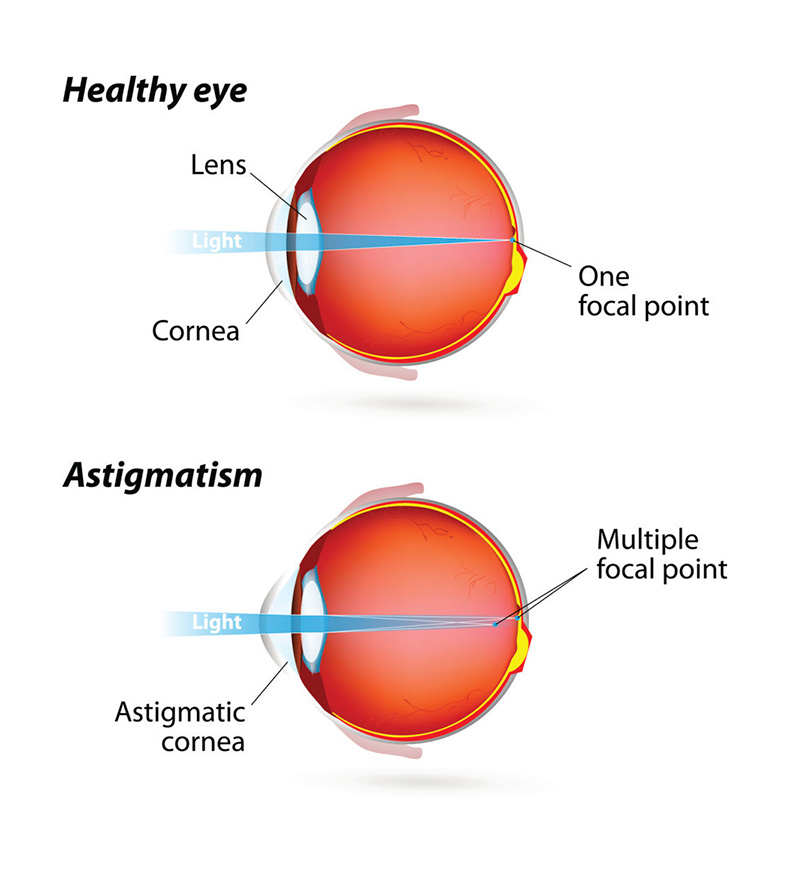Understanding Astigmatism

Astigmatism. Eye disease. Healthy eye and Astigmatic eye
You’ve probably heard the term “astigmatism”, but if you’re like many people, you don’t have any idea what it means. In fact, you may even think that the term is “a stigmatism”- that’s a persistent misconception. In fact, astigmatism is a common eye condition that can be diagnosed with a simple eye exam. It’s not a disease, but merely a problem with the way your eye focuses light.
- Symptoms of astigmatism include blurred or distorted vision, at all distances. If you’ve got astigmatism you might experience eye strain, headaches, eye irritation, and squinting.
- Astigmatism is typically caused by a cornea that’s irregularly shaped. The cornea is usually shaped like a ball, but in cases of astigmatism, it’s more egg-shaped. If you think of the front of your eye as the face of a clock, and picture one line connecting the 12 and 6, and one line connecting the 3 and nine, you’re picturing the eye’s meridians. When one meridian is significantly more curved than the other, it causes the irregularly shaped cornea of astigmatism. Sometimes, though, a distortion in the shape of the lens is the cause of astigmatism, and this is called lenticular astigmatism.
- There are three main types of astigmatism. Myopic astigmatism happens when one or both principal meridians are nearsighted, while hyperopic astigmatism indicates that one or both are farsighted. In mixed astigmatism, one meridian is nearsighted, while the other is farsighted.
- Your doctor can diagnose astigmatism during a routine eye exam. He or she can estimate the amount of astigmatism with a test called retinoscopy, which involves shining a light into the eye while introducing a series of lenses between the light and the eye.
- There are a few different options for correcting astigmatism. It can be corrected with eyeglasses or contact lenses, or your doctor may recommend refractive surgery. Refractive surgery is a laser procedure that changes the shape of your eyes, so it’s not typically the first method of treatment suggested. This is because it comes with the types of risks you’d expect from surgery.
- It’s important to treat astigmatism as soon as possible. Especially for children, untreated astigmatism can pose problems because of its impact on a child’s school performance. Once you’ve been diagnosed with astigmatism, you’ll need to have regular visits with your eye doctor. These visits are necessary because astigmatism can fluctuate over time, which makes it necessary for your doctor to modify your prescriptions as your vision changes.
If you’re looking for an ophthalmologist or optometrist in Derry, Londonderry or Windham, Spindel Eye Associates is here for you. Celebrating our thirtieth year of eye care, we proudly provide our patients with personalized eye care, using top-of-the-line technology. For more information or to schedule an appointment call 603.421.6536 or contact us through our website.
RECENT POSTS
categories
- Uncategorized
- Eye Exams
- Lasik
- Spindel Eye Reviews
- Cataracts
- Dry Eyes
- Refractive Errors
- Infographic
- Glaucoma
- Macular Degeneration
- Ocular Diseases
- Pulsed Light Therapy
- IPL
- eye care
- eye health
- Eye irritation
- Eye Syndrome
- Eye Doctors
- Diabetes
- Contacts
- LASIK Surgery
- dry eye syndrome Manchester
- Glasses
- Vision Care
- LipiFlow
- Contact Lenses
- Astigmatism
- Crizal Prevencia
- Spindel Eye
- Children
- skin cancer
- Sunglasses
